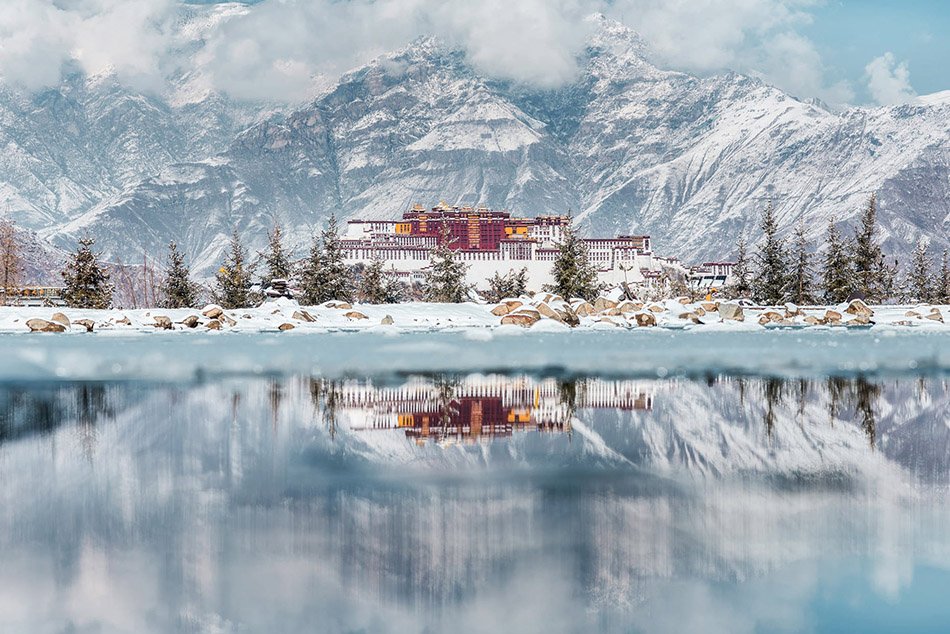Can I Travel Tibet Alone as A Foreigner?
Table of contents
Introduction
The towering peaks of the Himalayas, the flutter of vibrant prayer flags, and the echoes of ancient Buddhist chants – Tibet has long captured the imagination of adventurous travelers seeking transcendent experiences. This remote region, often referred to as the “Roof of the World,” promises landscapes that defy description and cultural immersion opportunities unlike anywhere else on the planet.

But for foreign visitors dreaming of a solo trek across Tibet’s windswept plateaus and an intimate exploration of its age-old monasteries, the reality is a harsh wake-up call. Independent solo travel in Tibet is currently prohibited for international tourists due to strict regulations imposed by Chinese authorities.
So can you really travel Tibet alone as a foreigner? The short answer is no – but that doesn’t mean the dream has to die. With some flexibility, proper guidance, and a deeper understanding of the situation on the ground, there are still incredible opportunities to experience the magic of Tibet…just not entirely on your own terms.
Understanding the Travel Restrictions
Why Solo Travel is Banned
Let’s start by addressing the elephant in the room – why can’t foreigners travel solo in Tibet? The restrictions stem from political factors and concerns over perceived safety risks in this semi-autonomous region of China.
Officially, Chinese authorities cite preserving local cultures, protecting the environment, and managing tourism flows as the reasons behind limiting independent foreign travel. Critics argue the real motivations are more about exerting control and limiting outside influences in the wake of past unrest and advocacy for Tibetan independence.
Regardless of the rationale, the rules are clear: all foreign nationals must be part of an organized tour group with approved guides and itineraries to legally enter Tibet.
The Permit Maze
Even when traveling with a sanctioned tour operator, obtaining the necessary permits is a bureaucratic maze that can test the patience of even the most seasoned traveler. At the top of the list is the Tibet Travel Permit, which can ONLY be obtained through a registered Tibetan tour company recognized by China’s tourism authorities.
But the permits don’t stop there. Depending on your planned itinerary, you may also need an Alien’s Travel Permit for journeying into certain border areas near Nepal or India. Additional “restricted area” permits can be required for venturing off the typical tourist routes.
The permit puzzle is part of why independent solo travel is essentially impossible – it’s near-impossible for a lone foreign traveler to secure legitimate permits without a registered tour operator’s assistance.
Embracing the Guided Group Experience
So if going solo is out of the question, does that mean your Tibetan travel dreams are dashed? Not at all – it just means adjusting your expectations and embracing the guided group tour model, which is currently the only legal avenue for foreigners to experience Tibet’s marvels.
The Benefits of an Organized Tour

While certainly more restrictive than a freewheeling solo adventure, organized tours to Tibet offer some distinct advantages. Most importantly, you’ll be accompanied by experienced guides who know the lay of the land, can provide crucial navigation over confusing terrain, and offer insights into the region’s rich cultural heritage.
Good Tibetan guides aren’t just leading tour groups – they’re ambassadors skilled at facilitating meaningful connections with local communities and customs. From arranging authentic homestays to decoding the ancient symbolism in monastery artwork, a knowledgeable guide can unlock doors that would remain firmly closed to a solo traveler.
Organized tours also take the logistical headaches off your plate. Navigating the high altitudes, arranging transportation over rough mountain roads, securing permits and travel documents – your tour operator handles all those details so you can focus on being present.
Finding the Right Fit
Of course, not all Tibet tour groups are created equal. Doing your research is crucial to find an operator and itinerary that aligns with your travel style and priorities. Maybe you want a small group experience that allows for more spontaneity. Or perhaps you prefer a private guided tour that comes with higher price tag but increased exclusivity.
Some travelers are drawn to cultural immersion through activities like meditation retreats or Buddhist festivals, while others are seeking the physical thrills of mountain trekking or mountaineering expeditions. Factoring in your interests, fitness levels, and budget will help identify the right tour for your needs.
There are also opportunities to spice up your guided experience with a few nights at rustic homestays or camping under the brilliant Himalayan skies. While you won’t have total autonomy, these types of excursions allow you to step slightly off the beaten path.
Navigating Cultural Nuances

Whether traveling solo was an option or not, navigating the vast cultural differences between your home country and Tibet is something every foreign visitor must prioritize. A little preparation goes a long way in avoiding cultural missteps and fostering rewarding cross-cultural connections.
Mind Your Manners
As a predominantly Buddhist society, there are certain etiquette norms that all travelers should observe in Tibet. Removing shoes before entering monasteries and homes is a must, as is dressing conservatively to respect modesty values. Photographing individuals, especially monks, often requires advance permission.
Your tour guide will be a fountain of knowledge on local customs, but doing some upfront research doesn’t hurt. Learning a few basic Tibetan language pleasantries is a polite gesture too.
Appreciating Religious Traditions
Buddhism is deeply interwoven into every aspect of Tibetan culture. From the ubiquitous monasteries and temples to the vibrant prayer flags fluttering in the mountain winds, you’ll be immersed in spirituality at every turn.
While you don’t have to be Buddhist yourself, having an open-mind towards appreciating – not appropriating – these ancient rituals and beliefs is paramount. Attending festivals or partaking in activities like Buddhist meditation can foster a deeper connection, but only when done respectfully. Your guide can ensure you’re a culturally-aware observer, not an inappropriate interloper.
Why Bother With the Hassles?
With all the regulations, tour requirements, and etiquette considerations, you may be wondering – is traveling to Tibet really worth jumping through all these hoops as a foreigner? The answer is a resounding yes if you crave perspective-shifting adventures.
Landscapes Like Nowhere Else
Few places on our planet can match the sheer, spellbinding beauty of Tibet’s landscapes. Stretching from the soaring peaks of the Himalayas to the windswept plateaus and turquoise alpine lakes, the scenery here is downright humbling. Pristine wilderness areas like Qomolangma National Park showcase nature’s untamed glory.
Whether your aim is ambitious trekking or just soaking in the jaw-dropping mountain vistas, having a guide makes navigating the challenges of altitude and rugged terrain infinitely easier. And with their wealth of knowledge about local geology and wildlife, they can elevate your appreciation for these magnificent ecosystems.
Unlocking Tibet’s Living History

While natural wonders abound, it’s the tangible echoes of Tibet’s human civilization that make this region so spellbinding for culturally-curious travelers. The Potala Palace, Jokhang Monastery, and countless other ancient Buddhist sites offer a living tapestry of Tibetan heritage.
Exploring these relics isn’t just about checking items off your bucket list but about connecting with a way of life that has remained relatively unchanged over centuries. With a guide’s expertise to provide context, you can gain a profound respect for the enduring relevance of Tibetan traditions.
Whether attending a centuries-old monastic debate or sharing butter tea with welcoming villagers, these are the types of immersive experiences that forge transformative travel memories.
The Way Forward
So while embarking on a solo backpacking quest across Tibet’s remote corners is currently off the table for international tourists, there are still incredible opportunities to experience this mystical region’s wonders. The key is adjusting your expectations, working within the established tour guidelines, and opening your mind to authentic connections facilitated by knowledgeable local guides.
Perhaps the regulations around independent foreign travel in Tibet will loosen one day. But for now, both responsible travelers and engaged global citizens should embrace the guided group model as the best way to uplift communities, protect fragile ecosystems, and foster cross-cultural understanding in this captivating part of the world.
Because at the end of the day, the breathtaking beauty of Tibet and the warm hospitality of its resilient people aren’t meant to be experienced as a solo adventure. This is a ancient land that has endured for millennia, patiently waiting to share its mysteries and magic with respectful visitors – just not alone.








